Seat Belt Buckle Switch (LH) (B1656)
DESCRIPTION
The front seat
belt buckle switch LH circuit consists of the airbag ECU assembly and
front seat belt buckle switch LH (front seat inner belt assembly LH).
DTC B1656 is stored when a malfunction is detected in the front seat belt buckle switch LH circuit.
|
DTC No. | Detection Item |
DTC Detection Condition | Trouble Area |
Warning Indicate | Test Mode / Check Mode |
|
B1656 | Seat Belt Buckle Switch (LH) |
- The airbag ECU assembly detects a line short, short to ground or B+, or an open in the front seat belt buckle switch LH circuit.
- Front seat belt buckle switch LH malfunction
- Airbag ECU assembly malfunction
|
- Floor wire
- Front seat belt buckle switch LH (Front seat inner belt assembly LH)
- Airbag ECU assembly
| Comes on |
Does not apply to test/check mode |
WIRING DIAGRAM
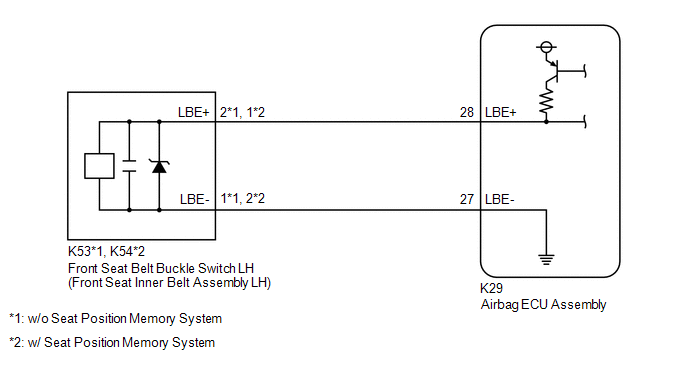
CAUTION / NOTICE / HINT
NOTICE:
After
turning the engine switch off, waiting time may be required before
disconnecting the cable from the negative (-) battery terminal.
Therefore, make sure to read the disconnecting the cable from the
negative (-) battery terminal notices before proceeding with work.
Click here

PROCEDURE
| 1. |
CHECK CONNECTION OF CONNECTORS |
(a) Turn the engine switch off.
(b) Disconnect the cable from the negative (-) battery terminal.
CAUTION:
Wait at least 90 seconds after disconnecting the cable from the negative (-) battery terminal to disable the SRS system.
(c) Check that the connectors are properly connected to the airbag ECU assembly and front seat inner belt assembly LH.
OK:
The connectors are properly connected.
| NG |
 | CONNECT CONNECTORS PROPERLY |
|
OK |
 | |
(a) Disconnect the connectors from the airbag ECU assembly and front seat inner belt assembly LH.
(b) Check that the terminals of the connectors are not deformed or damaged.
OK:
The terminals are not deformed or damaged.
| NG |
 | REPLACE FLOOR WIRE OR FRONT SEAT INNER BELT ASSEMBLY LH |
|
OK |
 | |
(a) Connect the cable to the negative (-) battery terminal.
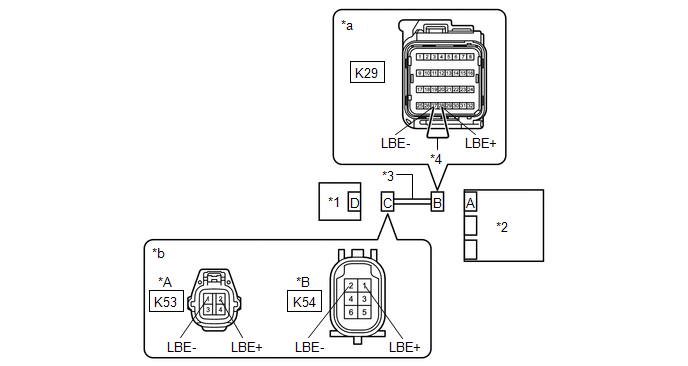
|
*A | w/o Seat Position Memory System |
*B | w/ Seat Position Memory System |
|
*1 | Front Seat Inner Belt Assembly LH |
*2 | Airbag ECU Assembly |
|
*3 | Floor Wire |
*4 | Service Wire |
|
*a | Front view of wire harness connector
(to Airbag ECU Assembly) |
*b | Front view of wire harness connector
(to Front Seat Inner Belt Assembly LH) |
(b) Turn the engine switch on (IG).
(c) Measure the voltage according to the value(s) in the table below.
Standard Voltage:
w/o Seat Position Memory System: |
Tester Connection | Condition |
Specified Condition |
|
K53-2 (LBE+) - Body ground |
Engine switch on (IG) |
Below 1 V |
|
K53-1 (LBE-) - Body ground |
Engine switch on (IG) |
Below 1 V |
w/ Seat Position Memory System: |
Tester Connection | Condition |
Specified Condition |
|
K54-1 (LBE+) - Body ground |
Engine switch on (IG) |
Below 1 V |
|
K54-2 (LBE-) - Body ground |
Engine switch on (IG) |
Below 1 V |
(d) Turn the engine switch off.
(e) Disconnect the cable from the negative (-) battery terminal.
CAUTION:
Wait at least 90 seconds after disconnecting the cable from the negative (-) battery terminal to disable the SRS system.
(f) Using a service wire, connect terminals 28 (LBE+) and 27 (LBE-) of connector B.
NOTICE:
Do not forcibly insert the service wire into the terminals of the connector when connecting the wire.
(g) Measure the resistance according to the value(s) in the table below.
Standard Resistance:
w/o Seat Position Memory System: |
Tester Connection | Condition |
Specified Condition |
|
K53-2 (LBE+) - K53-1 (LBE-) |
Always | Below 1 Ω |
w/ Seat Position Memory System: |
Tester Connection | Condition |
Specified Condition |
|
K54-1 (LBE+) - K54-2 (LBE-) |
Always | Below 1 Ω |
(h) Disconnect the service wire from connector B.
(i) Measure the resistance according to the value(s) in the table below.
Standard Resistance:
w/o Seat Position Memory System: |
Tester Connection | Condition |
Specified Condition |
|
K53-2 (LBE+) - K53-1 (LBE-) |
Always | 1 MΩ or higher |
|
K53-2 (LBE+) - Body ground |
Always | 1 MΩ or higher |
|
K53-1 (LBE-) - Body ground |
Always | 1 MΩ or higher |
w/ Seat Position Memory System: |
Tester Connection | Condition |
Specified Condition |
|
K54-1 (LBE+) - K54-2 (LBE-) |
Always | 1 MΩ or higher |
|
K54-1 (LBE+) - Body ground |
Always | 1 MΩ or higher |
|
K54-2 (LBE-) - Body ground |
Always | 1 MΩ or higher |
| NG |
 | REPLACE FLOOR WIRE |
|
OK |
 | |
| (a) Connect the connectors to the airbag ECU assembly and front seat inner belt assembly LH. |
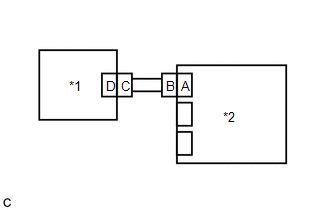 |
|
*1 | Front Seat Inner Belt Assembly LH | |
*2 | Airbag ECU Assembly | | |
(b) Connect the cable to the negative (-) battery terminal.
(c) Turn the engine switch on (IG), and wait for at least 60 seconds.
(d) Clear the DTCs stored in memory.
Body Electrical > SRS Airbag > Clear DTCs
(e) Turn the engine switch off.
(f) Turn the engine switch on (IG), and wait for at least 60 seconds.
(g) Check for DTCs.
Body Electrical > SRS Airbag > Trouble Codes
OK:
DTC B1656 is not output.
HINT:
Codes other than DTC B1656 may be output at this time, but they are not related to this check.
| OK |
 | USE SIMULATION METHOD TO CHECK |
|
NG |
 | |
| 5. |
CHECK FRONT SEAT INNER BELT ASSEMBLY LH |
| (a) Turn the engine switch off. |
 |
|
*1 | Front Seat Inner Belt Assembly LH | |
*2 | Airbag ECU Assembly | | |
(b) Disconnect the cable from the negative (-) battery terminal.
CAUTION:
Wait at least 90 seconds after disconnecting the cable from the negative (-) battery terminal to disable the SRS system.
(c) Replace the front seat inner belt assembly LH with a known good one.
Click here 
HINT:
Perform the following inspection using known good parts from another vehicle if possible.
(d) Connect the cable to the negative (-) battery terminal.
(e) Turn the engine switch on (IG), and wait for at least 60 seconds.
(f) Clear the DTCs stored in memory.
Body Electrical > SRS Airbag > Clear DTCs
(g) Turn the engine switch off.
(h) Turn the engine switch on (IG), and wait for at least 60 seconds.
(i) Check for DTCs.
Body Electrical > SRS Airbag > Trouble Codes
OK:
DTC B1656 is not output.
HINT:
Codes other than DTC B1656 may be output at this time, but they are not related to this check.
(j) Turn the engine switch off.
(k) Disconnect the cable from the negative (-) battery terminal.
CAUTION:
Wait at least 90 seconds after disconnecting the cable from the negative (-) battery terminal to disable the SRS system.
(l) Restore the front seat inner belt assembly LH that was installed for testing to its original location.
Click here 
| OK |
 | REPLACE FRONT SEAT INNER BELT ASSEMBLY LH |
| NG |
 | REPLACE AIRBAG ECU ASSEMBLY |
P Seat Airbag Active Mode Indicator (B1660)
DESCRIPTION
The passenger
airbag ON/OFF indicator circuit consists of the airbag ECU assembly and
passenger airbag ON/OFF indicator (radio and display receiver assembly).
The
passenger airbag ON/OFF indicator indicates the operation condition of
the instrument panel passenger airbag assembly and lower No. 2
instrument panel airbag assembly.
DTC B1660 is stored when a malfunction is detected in the passenger airbag ON/OFF indicator circuit.
|
DTC No. | Detection Item |
DTC Detection Condition | Trouble Area |
Warning Indicate | Test Mode / Check Mode |
|
B1660 | P Seat Airbag Active Mode Indicator |
- The airbag ECU assembly detects a line short, short to ground or B+, or
an open in the passenger airbag ON/OFF indicator circuit.
- Passenger airbag ON/OFF indicator malfunction
- Airbag ECU assembly malfunction
|
- Instrument panel wire
- Instrument panel junction block assembly
- Passenger airbag ON/OFF indicator (Radio and display receiver assembly)
- Airbag ECU assembly
| Comes on |
Does not apply to test/check mode |
WIRING DIAGRAM
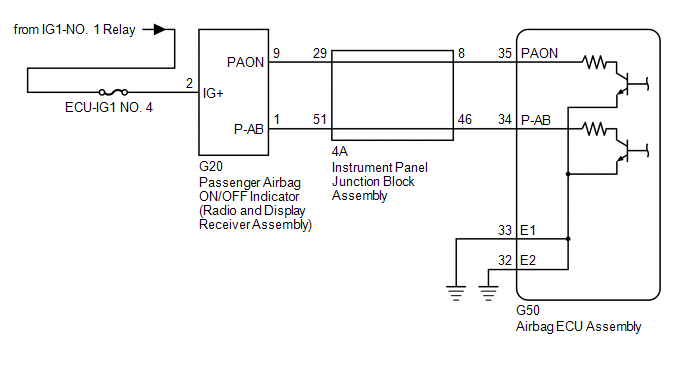
CAUTION / NOTICE / HINT
NOTICE:
- After turning the engine switch off, waiting time may be required before
disconnecting the cable from the negative (-) battery terminal.
Therefore, make sure to read the disconnecting the cable from the
negative (-) battery terminal notices before proceeding with work.
Click here 
- Inspect the fuses for circuits related to this system before performing the following procedure.
PROCEDURE
|
1. | CHECK PASSENGER AIRBAG ON/OFF INDICATOR CONDITION |
(a) Turn the engine switch on (IG).
(b) Check the passenger airbag ON/OFF indicator operation.
HINT:
Refer to the normal condition of the passenger airbag ON/OFF indicator.
Click here 
|
Result | Proceed to |
|
Passenger airbag ON/OFF indicator illumination is always on. |
A |
| Passenger airbag ON/OFF indicator illumination is always off. |
B |
| B |
 | GO TO STEP 8 |
|
A |
 | |
| 2. |
CHECK CONNECTION OF CONNECTORS |
(a) Turn the engine switch off.
(b) Disconnect the cable from the negative (-) battery terminal.
CAUTION:
Wait at least 90 seconds after disconnecting the cable from the negative (-) battery terminal to disable the SRS system.
(c)
Check that the connectors are properly connected to the airbag ECU
assembly, radio and display receiver assembly and instrument panel
junction block assembly.
OK:
The connectors are properly connected.
| NG |
 | CONNECT CONNECTORS PROPERLY |
|
OK |
 | |
(a)
Disconnect the connectors from the airbag ECU assembly, radio and
display receiver assembly and instrument panel junction block assembly.
(b) Check that the terminals of the connectors are not deformed or damaged.
OK:
The terminals are not deformed or damaged.
| NG |
 | REPLACE INSTRUMENT PANEL WIRE |
|
OK |
 | |
| 4. |
CHECK PASSENGER AIRBAG ON/OFF INDICATOR CONDITION |
(a) Connect the connector to the radio and display receiver assembly and instrument panel junction block assembly.
(b) Connect the cable to the negative (-) battery terminal.
(c) Turn the engine switch on (IG).
(d) Check the passenger airbag ON/OFF indicator operation.
OK:
The passenger airbag ON/OFF indicator does not come on.
| NG |
 | GO TO STEP 6 |
|
OK |
 | |
| (a) Turn the engine switch off. |
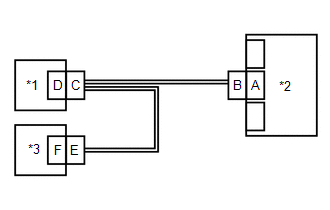 |
|
*1 | Instrument Panel Junction Block Assembly | |
*2 | Airbag ECU Assembly | |
*3 | Radio and Display Receiver Assembly | | |
(b) Disconnect the cable from the negative (-) battery terminal.
CAUTION:
Wait at least 90 seconds after disconnecting the cable from the negative (-) battery terminal to disable the SRS system.
(c) Connect the connector to the airbag ECU assembly.
(d) Connect the cable to the negative (-) battery terminal.
(e) Turn the engine switch on (IG), and wait for at least 60 seconds.
(f) Clear the DTCs stored in memory.
Body Electrical > SRS Airbag > Clear DTCs
(g) Turn the engine switch off.
(h) Turn the engine switch on (IG), and wait for at least 60 seconds.
(i) Check for DTCs.
Body Electrical > SRS Airbag > Trouble Codes
OK:
DTC B1660 is not output.
HINT:
Codes other than DTC B1660 may be output at this time, but they are not related to this check.
| OK |
 | USE SIMULATION METHOD TO CHECK |
| NG |
 | REPLACE AIRBAG ECU ASSEMBLY |
| (a) Turn the engine switch off. |
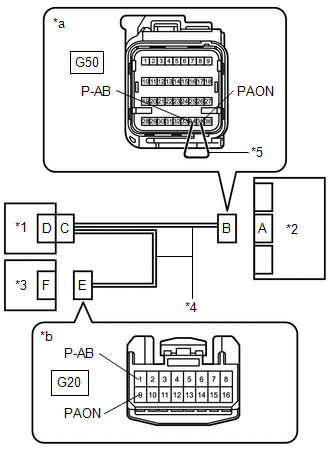 |
|
*1 | Instrument Panel Junction Block Assembly | |
*2 | Airbag ECU Assembly | |
*3 | Radio and Display Receiver Assembly | |
*4 | Instrument Panel Wire | |
*5 | Service Wire | |
*a | Front view of wire harness connector
(to Airbag ECU Assembly) | |
*b | Front view of wire harness connector
(to Radio and Display Receiver Assembly) | | |
(b) Disconnect the cable from the negative (-) battery terminal.
CAUTION:
Wait at least 90 seconds after disconnecting the cable from the negative (-) battery terminal to disable the SRS system.
(c) Disconnect the connector from the radio and display receiver assembly.
(d) Connect the cable to the negative (-) battery terminal.
(e) Turn the engine switch on (IG).
(f) Measure the voltage according to the value(s) in the table below.
Standard Voltage:
|
Tester Connection | Condition |
Specified Condition |
|
G20-9 (PAON) - Body ground |
Engine switch on (IG) |
Below 1 V |
|
G20-1 (P-AB) - Body ground |
Engine switch on (IG) |
Below 1 V |
(g) Turn the engine switch off.
(h) Disconnect the cable from the negative (-) battery terminal.
CAUTION:
Wait at least 90 seconds after disconnecting the cable from the negative (-) battery terminal to disable the SRS system.
(i) Using a service wire, connect terminals 35 (PAON) and 34 (P-AB) of connector B.
NOTICE:
Do not forcibly insert the service wire into the terminals of the connector when connecting the wire.
(j) Measure the resistance according to the value(s) in the table below.
Standard Resistance:
|
Tester Connection | Condition |
Specified Condition |
|
G20-9 (PAON) - G20-1 (P-AB) |
Always | Below 1 Ω |
(k) Disconnect the service wire from connector B.
(l) Measure the resistance according to the value(s) in the table below.
Standard Resistance:
|
Tester Connection | Condition |
Specified Condition |
|
G20-9 (PAON) - G20-1 (P-AB) |
Always | 1 MΩ or higher |
|
G20-9 (PAON) - Body ground |
Always | 1 MΩ or higher |
|
G20-1 (P-AB) - Body ground |
Always | 1 MΩ or higher |
| OK |
 | REPLACE RADIO AND DISPLAY RECEIVER ASSEMBLY |
|
NG |
 | |
| 7. |
CHECK INSTRUMENT PANEL WIRE |
(a) Disconnect the connector from the instrument panel junction block assembly.
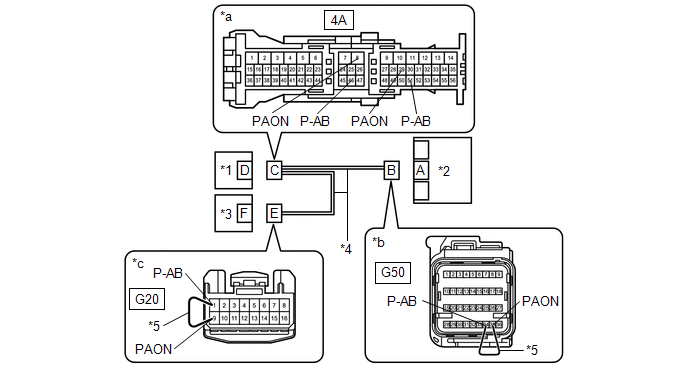
|
*1 | Instrument Panel Junction Block Assembly |
*2 | Airbag ECU Assembly |
|
*3 | Radio and Display Receiver Assembly |
*4 | Instrument Panel Wire |
|
*5 | Service Wire |
- | - |
|
*a | Front view of wire harness connector
(to Instrument Panel Junction Block Assembly) |
*b | Front view of wire harness connector
(to Airbag ECU Assembly) |
|
*c | Front view of wire harness connector
(to Radio and Display Receiver Assembly) |
- | - |
(b) Using a service wire, connect terminals 35 (PAON) and 34 (P-AB) of connector B.
NOTICE:
Do not forcibly insert the service wire into the terminals of the connector when connecting the wire.
(c) Measure the resistance according to the value(s) in the table below.
Standard Resistance:
|
Tester Connection | Condition |
Specified Condition |
|
4A-8 (PAON) - 4A-46 (P-AB) |
Always | Below 1 Ω |
(d) Disconnect the service wire from connector B.
(e) Using a service wire, connect terminals 9 (PAON) and 1 (P-AB) of connector E.
NOTICE:
Do not forcibly insert the service wire into the terminals of the connector when connecting the wire.
(f) Measure the resistance according to the value(s) in the table below.
Standard Resistance:
|
Tester Connection | Condition |
Specified Condition |
|
4A-29 (PAON) - 4A-51 (P-AB) |
Always | Below 1 Ω |
(g) Disconnect the service wire from connector E.
(h) Measure the resistance according to the value(s) in the table below.
Standard Resistance:
|
Tester Connection | Condition |
Specified Condition |
|
4A-8 (PAON) - Body ground or other terminals |
Always | 1 MΩ or higher |
|
4A-29 (PAON) - Body ground or other terminals |
Always | 1 MΩ or higher |
|
4A-46 (P-AB) - Body ground or other terminals |
Always | 1 MΩ or higher |
|
4A-51 (P-AB) - Body ground or other terminals |
Always | 1 MΩ or higher |
| OK |
 | REPLACE INSTRUMENT PANEL JUNCTION BLOCK ASSEMBLY |
| NG |
 | REPLACE INSTRUMENT PANEL WIRE |
| 8. |
CHECK CONNECTION OF CONNECTORS |
(a) Turn the engine switch off.
(b) Disconnect the cable from the negative (-) battery terminal.
CAUTION:
Wait at least 90 seconds after disconnecting the cable from the negative (-) battery terminal to disable the SRS system.
(c)
Check that the connectors are properly connected to the airbag ECU
assembly, radio and display receiver assembly and instrument panel
junction block assembly.
OK:
The connectors are properly connected.
| NG |
 | CONNECT CONNECTORS PROPERLY |
|
OK |
 | |
(a)
Disconnect the connectors from the airbag ECU assembly, radio and
display receiver assembly and instrument panel junction block assembly.
(b) Check that the terminals of the connectors are not deformed or damaged.
OK:
The terminals are not deformed or damaged.
| NG |
 | REPLACE INSTRUMENT PANEL WIRE |
|
OK |
 | |
| (a) Connect the connector to the instrument panel junction block assembly. |
 |
|
*1 | Instrument Panel Junction Block Assembly | |
*2 | Airbag ECU Assembly | |
*3 | Radio and Display Receiver Assembly | |
*4 | Instrument Panel Wire | |
*5 | Service Wire | |
*a | Front view of wire harness connector
(to Airbag ECU Assembly) | |
*b | Front view of wire harness connector
(to Radio and Display Receiver Assembly) | | |
(b) Connect the cable to the negative (-) battery terminal.
(c) Turn the engine switch on (IG).
(d) Measure the voltage according to the value(s) in the table below.
Standard Voltage:
|
Tester Connection | Condition |
Specified Condition |
|
G20-9 (PAON) - Body ground |
Engine switch on (IG) |
Below 1 V |
|
G20-1 (P-AB) - Body ground |
Engine switch on (IG) |
Below 1 V |
(e) Turn the engine switch off.
(f) Disconnect the cable from the negative (-) battery terminal.
CAUTION:
Wait at least 90 seconds after disconnecting the cable from the negative (-) battery terminal to disable the SRS system.
(g) Using a service wire, connect terminals 35 (PAON) and 34 (P-AB) of connector B.
NOTICE:
Do not forcibly insert the service wire into the terminals of the connector when connecting the wire.
(h) Measure the resistance according to the value(s) in the table below.
Standard Resistance:
|
Tester Connection | Condition |
Specified Condition |
|
G20-9 (PAON) - G20-1 (P-AB) |
Always | Below 1 Ω |
(i) Disconnect the service wire from connector B.
(j) Measure the resistance according to the value(s) in the table below.
Standard Resistance:
|
Tester Connection | Condition |
Specified Condition |
|
G20-9 (PAON) - G20-1 (P-AB) |
Always | 1 MΩ or higher |
|
G20-9 (PAON) - Body ground |
Always | 1 MΩ or higher |
|
G20-1 (P-AB) - Body ground |
Always | 1 MΩ or higher |
| NG |
 | GO TO STEP 14 |
|
OK |
 | |
| 11. |
CHECK PASSENGER AIRBAG ON/OFF INDICATOR (SOURCE VOLTAGE) |
| (a) Connect the cable to the negative (-) battery terminal. |
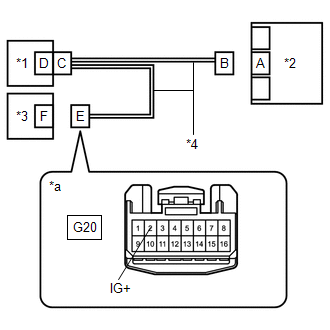 |
|
*1 | Instrument Panel Junction Block Assembly | |
*2 | Airbag ECU Assembly | |
*3 | Radio and Display Receiver Assembly | |
*4 | Instrument Panel Wire | |
*a | Front view of wire harness connector
(to Radio and Display Receiver Assembly) | | |
(b) Turn the engine switch on (IG).
(c) Measure the voltage according to the value(s) in the table below.
Standard Voltage:
|
Tester Connection | Condition |
Specified Condition |
|
G20-2 (IG+) - Body ground |
Engine switch on (IG) |
11 to 14 V |
(d) Turn the engine switch off.
(e) Disconnect the cable from the negative (-) battery terminal.
CAUTION:
Wait at least 90 seconds after disconnecting the cable from the negative (-) battery terminal to disable the SRS system.
| NG |
 | REPLACE WIRE HARNESS OR BATTERY |
|
OK |
 | |
| 12. |
CHECK PASSENGER AIRBAG ON/OFF INDICATOR |
| (a) Connect the connector to the radio and display receiver assembly. |
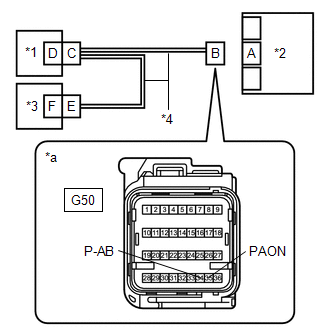 |
|
*1 | Instrument Panel Junction Block Assembly | |
*2 | Airbag ECU Assembly | |
*3 | Radio and Display Receiver Assembly | |
*4 | Instrument Panel Wire | |
*a | Front view of wire harness connector
(to Airbag ECU Assembly) | | |
(b) Connect the cable to the negative (-) battery terminal.
(c) Turn the engine switch on (IG).
(d) Check the passenger airbag ON/OFF indicator according to the conditions in the table below.
OK:
|
Terminal Connection | Condition |
Specified Condition |
|
G50-35 (PAON) - Body ground |
Engine switch on (IG) |
"ON" comes on |
|
G50-34 (P-AB) - Body ground |
Engine switch on (IG) |
"OFF" comes on |
(e) Turn the engine switch off.
(f) Disconnect the cable from the negative (-) battery terminal.
CAUTION:
Wait at least 90 seconds after disconnecting the cable from the negative (-) battery terminal to disable the SRS system.
| NG |
 | REPLACE RADIO AND DISPLAY RECEIVER ASSEMBLY |
|
OK |
 | |
| (a) Connect the connector to the airbag ECU assembly. |
 |
|
*1 | Instrument Panel Junction Block Assembly | |
*2 | Airbag ECU Assembly | |
*3 | Radio and Display Receiver Assembly | | |
(b) Connect the cable to the negative (-) battery terminal.
(c) Turn the engine switch on (IG), and wait for at least 60 seconds.
(d) Clear the DTCs stored in memory.
Body Electrical > SRS Airbag > Clear DTCs
(e) Turn the engine switch off.
(f) Turn the engine switch on (IG), and wait for at least 60 seconds.
(g) Check for DTCs.
Body Electrical > SRS Airbag > Trouble Codes
OK:
DTC B1660 is not output.
HINT:
Codes other than DTC B1660 may be output at this time, but they are not related to this check.
| OK |
 | USE SIMULATION METHOD TO CHECK |
| NG |
 | REPLACE AIRBAG ECU ASSEMBLY |
| 14. |
CHECK INSTRUMENT PANEL WIRE |
(a) Disconnect the connector from the instrument panel junction block assembly.

|
*1 | Instrument Panel Junction Block Assembly |
*2 | Airbag ECU Assembly |
|
*3 | Radio and Display Receiver Assembly |
*4 | Instrument Panel Wire |
|
*5 | Service Wire |
- | - |
|
*a | Front view of wire harness connector
(to Instrument Panel Junction Block Assembly) |
*b | Front view of wire harness connector
(to Airbag ECU Assembly) |
|
*c | Front view of wire harness connector
(to Radio and Display Receiver Assembly) |
- | - |
(b) Using a service wire, connect terminals 35 (PAON) and 34 (P-AB) of connector B.
NOTICE:
Do not forcibly insert the service wire into the terminals of the connector when connecting the wire.
(c) Measure the resistance according to the value(s) in the table below.
Standard Resistance:
|
Tester Connection | Condition |
Specified Condition |
|
4A-8 (PAON) - 4A-46 (P-AB) |
Always | Below 1 Ω |
(d) Disconnect the service wire from connector B.
(e) Using a service wire, connect terminals 9 (PAON) and 1 (P-AB) of connector E.
NOTICE:
Do not forcibly insert the service wire into the terminals of the connector when connecting the wire.
(f) Measure the resistance according to the value(s) in the table below.
Standard Resistance:
|
Tester Connection | Condition |
Specified Condition |
|
4A-29 (PAON) - 4A-51 (P-AB) |
Always | Below 1 Ω |
(g) Disconnect the service wire from connector E.
(h) Measure the resistance according to the value(s) in the table below.
Standard Resistance:
|
Tester Connection | Condition |
Specified Condition |
|
4A-8 (PAON) - Body ground or other terminals |
Always | 1 MΩ or higher |
|
4A-29 (PAON) - Body ground or other terminals |
Always | 1 MΩ or higher |
|
4A-46 (P-AB) - Body ground or other terminals |
Always | 1 MΩ or higher |
|
4A-51 (P-AB) - Body ground or other terminals |
Always | 1 MΩ or higher |
| OK |
 | REPLACE INSTRUMENT PANEL JUNCTION BLOCK ASSEMBLY |
| NG |
 | REPLACE INSTRUMENT PANEL WIRE |
Short in D Squib Circuit (B1800-B1803)
DESCRIPTION
The driver squib circuit consists of the airbag ECU assembly, spiral cable sub-assembly and horn button assembly.
The airbag ECU assembly uses this circuit to deploy the airbag when deployment conditions are met.
These DTCs are stored when a malfunction is detected in the driver squib circuit.
|
DTC No. | Detection Item |
DTC Detection Condition | Trouble Area |
Warning Indicate | Test Mode / Check Mode |
|
B1800 | Short in D Squib Circuit |
- The airbag ECU assembly detects a line short in the driver squib circuit during the primary check.
- Spiral cable sub-assembly malfunction
- Driver squib malfunction
- Airbag ECU assembly malfunction
|
- Instrument panel wire
- Spiral cable sub-assembly
- Driver squib (Horn button assembly)
- Airbag ECU assembly
| Comes on |
Applies to check mode |
|
B1801 | Open in D Squib Circuit |
- The airbag ECU assembly detects an open in the driver squib circuit.
- Spiral cable sub-assembly malfunction
- Driver squib malfunction
- Airbag ECU assembly malfunction
|
- Instrument panel wire
- Spiral cable sub-assembly
- Driver squib (Horn button assembly)
- Airbag ECU assembly
| Comes on |
Applies to check mode |
|
B1802 | Short in D Squib Circuit (to Ground) |
- The airbag ECU assembly detects a short to ground in the driver squib circuit.
- Spiral cable sub-assembly malfunction
- Driver squib malfunction
- Airbag ECU assembly malfunction
|
- Instrument panel wire
- Spiral cable sub-assembly
- Driver squib (Horn button assembly)
- Airbag ECU assembly
| Comes on |
Applies to check mode |
|
B1803 | Short in D Squib Circuit (to +B) |
- The airbag ECU assembly detects a short to B+ in the driver squib circuit.
- Spiral cable sub-assembly malfunction
- Driver squib malfunction
- Airbag ECU assembly malfunction
|
- Instrument panel wire
- Spiral cable sub-assembly
- Driver squib (Horn button assembly)
- Airbag ECU assembly
| Comes on |
Applies to check mode |
WIRING DIAGRAM
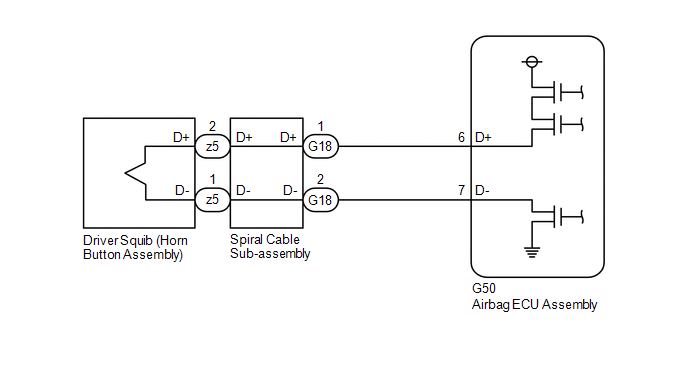
CAUTION / NOTICE / HINT
NOTICE:
After
turning the engine switch off, waiting time may be required before
disconnecting the cable from the negative (-) battery terminal.
Therefore, make sure to read the disconnecting the cable from the
negative (-) battery terminal notices before proceeding with work.
Click here

HINT:
- Perform the simulation method by selecting check mode (Signal Check) using the Techstream.
Click here 
- After selecting check mode (Signal Check), perform the simulation method
by wiggling each connector of the airbag system or driving the vehicle
on a city road or rough road.
Click here 
PROCEDURE
| (a) Turn the engine switch off. |
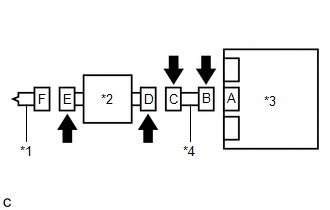 |
|
*1 | Horn Button Assembly | |
*2 | Spiral Cable Sub-assembly | |
*3 | Airbag ECU Assembly | |
*4 | Instrument Panel Wire | | |
(b) Disconnect the cable from the negative (-) battery terminal.
CAUTION:
Wait at least 90 seconds after disconnecting the cable from the negative (-) battery terminal to disable the SRS system.
(c)
Check that the connectors are properly connected to the horn button
assembly, spiral cable sub-assembly and airbag ECU assembly.
OK:
The connectors are properly connected.
HINT:
If the connectors are not properly connected, reconnect the connectors and proceed to the next inspection.
(d) Disconnect the connectors from the horn button assembly, spiral cable sub-assembly and airbag ECU assembly.
(e) Check that the terminals of the connectors are not deformed or damaged.
OK:
The terminals are not deformed or damaged.
(f) Check that the spiral cable sub-assembly connector (on the horn button assembly side) is not loose, deformed or damaged.
OK:
The airbag connector locking button is not disengaged, and the claw of the lock is not deformed or damaged.
(g)
Check that the short springs of the activation prevention mechanisms of
the instrument panel wire connector and spiral cable sub-assembly
connector are not deformed or damaged.
OK:
The short springs are not deformed or damaged.
| NG |
 | REPLACE WIRE HARNESS |
|
OK |
 | |
| 2. |
CHECK HORN BUTTON ASSEMBLY |
| (a) Connect the instrument panel wire to the airbag ECU assembly and spiral cable sub-assembly. |
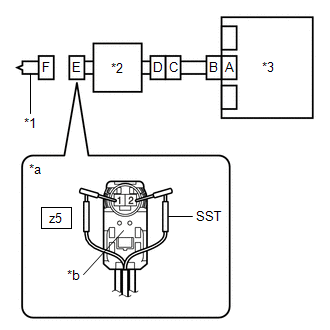 |
|
*1 | Horn Button Assembly | |
*2 | Spiral Cable Sub-assembly | |
*3 | Airbag ECU Assembly | |
*a | Front view of wire harness connector
(to Horn Button Assembly) | |
*b | Color: Light Green | | |
(b) Connect SST (resistance 2.1 Ω) to connector E (light green connector).
CAUTION:
Never
connect a tester to the horn button assembly for measurement, as this
may lead to a serious injury due to airbag deployment.
NOTICE:
- Do not forcibly insert SST into the terminals of the connector when connecting it.
- Insert SST straight into the terminals of the connector.
SST: 09843-18061
(c) Connect the cable to the negative (-) battery terminal.
(d) Turn the engine switch on (IG), and wait for at least 60 seconds.
(e) Clear the DTCs stored in memory.
Body Electrical > SRS Airbag > Clear DTCs
(f) Turn the engine switch off.
(g) Turn the engine switch on (IG), and wait for at least 60 seconds.
(h) Check for DTCs.
Body Electrical > SRS Airbag > Trouble Codes
OK:
DTC B1800, B1801, B1802 or B1803 is not output.
HINT:
Codes other than DTCs B1800, B1801, B1802 and B1803 may be output at this time, but they are not related to this check.
(i) Turn the engine switch off.
(j) Disconnect the cable from the negative (-) battery terminal.
CAUTION:
Wait at least 90 seconds after disconnecting the cable from the negative (-) battery terminal to disable the SRS system.
(k) Disconnect SST from connector E.
| OK |
 | REPLACE HORN BUTTON ASSEMBLY |
|
NG |
 | |
| 3. |
CHECK DRIVER SQUIB CIRCUIT |
| (a) Disconnect the instrument panel wire from the airbag ECU assembly. |
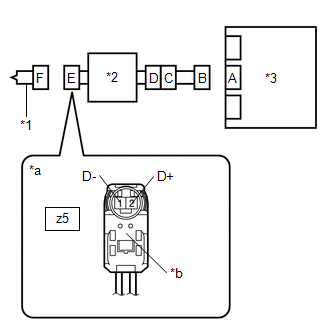 |
|
*1 | Horn Button Assembly | |
*2 | Spiral Cable Sub-assembly | |
*3 | Airbag ECU Assembly | |
*a | Front view of wire harness connector
(to Horn Button Assembly) | |
*b | Color: Light Green | | |
(b) Check for a short to B+ in the circuit.
(1) Connect the cable to the negative (-) battery terminal.
(2) Turn the engine switch on (IG).
(3) Measure the voltage according to the value(s) in the table below.
Standard Voltage:
|
Tester Connection | Condition |
Specified Condition |
|
z5-2 (D+) - Body ground |
Engine switch on (IG) |
Below 1 V |
|
z5-1 (D-) - Body ground |
Engine switch on (IG) |
Below 1 V |
(4) Turn the engine switch off.
(5) Disconnect the cable from the negative (-) battery terminal.
CAUTION:
Wait at least 90 seconds after disconnecting the cable from the negative (-) battery terminal to disable the SRS system.
(c) Check for an open in the circuit.
(1) Measure the resistance according to the value(s) in the table below.
Standard Resistance:
|
Tester Connection | Condition |
Specified Condition |
|
z5-2 (D+) - z5-1 (D-) |
Always | Below 1 Ω |
(d) Check for a short to ground in the circuit.
(1) Measure the resistance according to the value(s) in the table below.
Standard Resistance:
|
Tester Connection | Condition |
Specified Condition |
|
z5-2 (D+) - Body ground |
Always | 1 MΩ or higher |
|
z5-1 (D-) - Body ground |
Always | 1 MΩ or higher |
(e) Check for a short in the circuit.
(1) Release the activation prevention mechanism built into connector B.
Click here 
(2) Measure the resistance according to the value(s) in the table below.
Standard Resistance:
|
Tester Connection | Condition |
Specified Condition |
|
z5-2 (D+) - z5-1 (D-) |
Always | 1 MΩ or higher |
(3) Restore the released activation prevention mechanism of connector B to the original condition.
| NG |
 | GO TO STEP 5 |
|
OK |
 | |
| (a) Connect the connectors to the horn button assembly and airbag ECU assembly. |
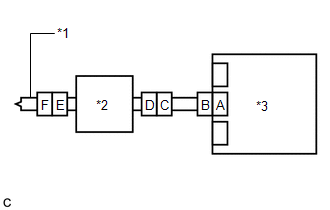 |
|
*1 | Horn Button Assembly | |
*2 | Spiral Cable Sub-assembly | |
*3 | Airbag ECU Assembly | | |
(b) Connect the cable to the negative (-) battery terminal.
(c) Turn the engine switch on (IG), and wait for at least 60 seconds.
(d) Clear the DTCs stored in memory.
Body Electrical > SRS Airbag > Clear DTCs
(e) Turn the engine switch off.
(f) Turn the engine switch on (IG), and wait for at least 60 seconds.
(g) Check for DTCs.
Body Electrical > SRS Airbag > Trouble Codes
OK:
DTC B1800, B1801, B1802 or B1803 is not output.
HINT:
Codes other than DTCs B1800, B1801, B1802 and B1803 may be output at this time, but they are not related to this check.
| OK |
 | USE SIMULATION METHOD TO CHECK |
| NG |
 | REPLACE AIRBAG ECU ASSEMBLY |
| 5. |
CHECK INSTRUMENT PANEL WIRE |
| (a) Disconnect the instrument panel wire from the spiral cable sub-assembly. |
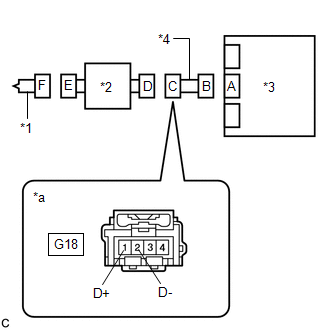 |
|
*1 | Horn Button Assembly | |
*2 | Spiral Cable Sub-assembly | |
*3 | Airbag ECU Assembly | |
*4 | Instrument Panel Wire | |
*a | Front view of wire harness connector
(to Spiral Cable Sub-assembly) | | |
(b) Check for a short to B+ in the circuit.
(1) Connect the cable to the negative (-) battery terminal.
(2) Turn the engine switch on (IG).
(3) Measure the voltage according to the value(s) in the table below.
Standard Voltage:
|
Tester Connection | Condition |
Specified Condition |
|
G18-1 (D+) - Body ground |
Engine switch on (IG) |
Below 1 V |
|
G18-2 (D-) - Body ground |
Engine switch on (IG) |
Below 1 V |
(4) Turn the engine switch off.
(5) Disconnect the cable from the negative (-) battery terminal.
CAUTION:
Wait at least 90 seconds after disconnecting the cable from the negative (-) battery terminal to disable the SRS system.
(c) Check for an open in the circuit.
(1) Measure the resistance according to the value(s) in the table below.
Standard Resistance:
|
Tester Connection | Condition |
Specified Condition |
|
G18-1 (D+) - G18-2 (D-) |
Always | Below 1 Ω |
(d) Check for a short to ground in the circuit.
(1) Measure the resistance according to the value(s) in the table below.
Standard Resistance:
|
Tester Connection | Condition |
Specified Condition |
|
G18-1 (D+) - Body ground |
Always | 1 MΩ or higher |
|
G18-2 (D-) - Body ground |
Always | 1 MΩ or higher |
(e) Check for a short in the circuit.
(1) Release the activation prevention mechanism built into connector B.
Click here 
(2) Measure the resistance according to the value(s) in the table below.
Standard Resistance:
|
Tester Connection | Condition |
Specified Condition |
|
G18-1 (D+) - G18-2 (D-) |
Always | 1 MΩ or higher |
(3) Restore the released activation prevention mechanism of connector B to the original condition.
| NG |
 | REPLACE INSTRUMENT PANEL WIRE |
|
OK |
 | |
| 6. |
CHECK SPIRAL CABLE SUB-ASSEMBLY |
| (a) Check for a short to B+ in the circuit. (1) Connect the cable to the negative (-) battery terminal.
(2) Turn the engine switch on (IG). (3) Measure the voltage according to the value(s) in the table below.
Standard Voltage: |
Tester Connection | Condition |
Specified Condition | |
z5-2 (D+) - Body ground |
Engine switch on (IG) |
Below 1 V | |
z5-1 (D-) - Body ground |
Engine switch on (IG) |
Below 1 V | (4) Turn the engine switch off.
(5) Disconnect the cable from the negative (-) battery terminal. CAUTION:
Wait at least 90 seconds after disconnecting the cable from the negative (-) battery terminal to disable the SRS system. |
 |
|
*1 | Horn Button Assembly | |
*2 | Spiral Cable Sub-assembly | |
*3 | Airbag ECU Assembly | |
*4 | Instrument Panel Wire | |
*a | Front view of wire harness connector
(to Horn Button Assembly) | |
*b | Color: Light Green | | |
(b) Check for an open in the circuit.
(1) Measure the resistance according to the value(s) in the table below.
Standard Resistance:
|
Tester Connection | Condition |
Specified Condition |
|
z5-2 (D+) - z5-1 (D-) |
Always | Below 1 Ω |
(c) Check for a short to ground in the circuit.
(1) Measure the resistance according to the value(s) in the table below.
Standard Resistance:
|
Tester Connection | Condition |
Specified Condition |
|
z5-2 (D+) - Body ground |
Always | 1 MΩ or higher |
|
z5-1 (D-) - Body ground |
Always | 1 MΩ or higher |
(d) Check for a short in the circuit.
(1) Release the activation prevention mechanism built into connector D.
Click here 
(2) Measure the resistance according to the value(s) in the table below.
Standard Resistance:
|
Tester Connection | Condition |
Specified Condition |
|
z5-2 (D+) - z5-1 (D-) |
Always | 1 MΩ or higher |
(3) Restore the released activation prevention mechanism of connector D to the original condition.
| OK |
 | USE SIMULATION METHOD TO CHECK |
| NG |
 | REPLACE SPIRAL CABLE SUB-ASSEMBLY |
















































































